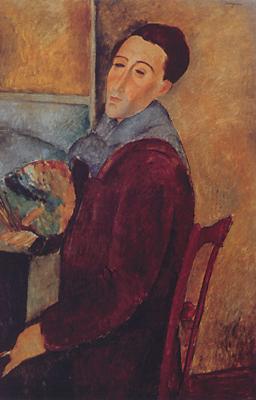|

 Modigliani was born on July 12, 1884 to a Sephardic
Jewish family living in reduced ciccumstances in Italy.
He began his formal art training in 1898, and in 1902
and 1903 he studied in Florence and Venice. In 1906 he
moved to Paris, with the help of a small allowance from
his mother.
Modigliani was born on July 12, 1884 to a Sephardic
Jewish family living in reduced ciccumstances in Italy.
He began his formal art training in 1898, and in 1902
and 1903 he studied in Florence and Venice. In 1906 he
moved to Paris, with the help of a small allowance from
his mother.
 He first settled in Montmarte; along with his closest
friends Soutine and Lipchitz, who were also expatriate
artists. He immersed himself in cafe and night life,
developing a dissolute life-style that enchanced his
reputation as a bohemian but eventually ruined his life. He first settled in Montmarte; along with his closest
friends Soutine and Lipchitz, who were also expatriate
artists. He immersed himself in cafe and night life,
developing a dissolute life-style that enchanced his
reputation as a bohemian but eventually ruined his life.
 Modigliani worked as wildly as he had lived. Alcohol
and hashish never diminished his great desire to work.
Neither did the numerous affairs with all kinds of
women. It seems his whole life was a series of protests:
against the bourgeois smugness of his family of
businessmen, against all that his art teacher Micheli
represented, and against a society that failed to
recognize and reward his talent. Modigliani worked as wildly as he had lived. Alcohol
and hashish never diminished his great desire to work.
Neither did the numerous affairs with all kinds of
women. It seems his whole life was a series of protests:
against the bourgeois smugness of his family of
businessmen, against all that his art teacher Micheli
represented, and against a society that failed to
recognize and reward his talent.
 Desperately poor, he scavenged stone from building
sites around Paris. His sculpture, like his paintings
emphasized elongated, simplified forms. He lost many
of his works because he could not pay his rent and had
to move a lot. He also never kept a record of his works. Desperately poor, he scavenged stone from building
sites around Paris. His sculpture, like his paintings
emphasized elongated, simplified forms. He lost many
of his works because he could not pay his rent and had
to move a lot. He also never kept a record of his works.
 As his health began to fail around 1914 he turned to
painting almost exclusively. Leopold Zborowski became
his exclusive representative and moved Modigliani to the
south of France in early 1918. Paris had become too
unstable because of the fighting during World War I. It
was here that he met Jeanne Hebuterne who became his
mistress. As his health began to fail around 1914 he turned to
painting almost exclusively. Leopold Zborowski became
his exclusive representative and moved Modigliani to the
south of France in early 1918. Paris had become too
unstable because of the fighting during World War I. It
was here that he met Jeanne Hebuterne who became his
mistress.
 By spring, they were back in Paris. Jeanne gave birth
to a daughter in the fall and his works were beginning
to sell. But, his health took a turn for the worse. He
died on January 24, 1920, of tubercular meningitis. The
following day Jeanne, nine months pregnant with her
second child, threw herself from a window of her
parents' home and died instantly. By spring, they were back in Paris. Jeanne gave birth
to a daughter in the fall and his works were beginning
to sell. But, his health took a turn for the worse. He
died on January 24, 1920, of tubercular meningitis. The
following day Jeanne, nine months pregnant with her
second child, threw herself from a window of her
parents' home and died instantly.
 Had the artist lived a few more years, he would have
witnessed a growing interest in his work. In 1921 there
was a memorial exhibition organized by Zborowski that
received great acclaim. A foreign collector named
Dr. Albert Barnes, in 1922 bought a large number of
his works. Had the artist lived a few more years, he would have
witnessed a growing interest in his work. In 1921 there
was a memorial exhibition organized by Zborowski that
received great acclaim. A foreign collector named
Dr. Albert Barnes, in 1922 bought a large number of
his works.
 What remains of Modigliani seven decades after his
death? First, there is the work, yet to be studied
thoroughly, and second, the legend, now known to
millions. What remains of Modigliani seven decades after his
death? First, there is the work, yet to be studied
thoroughly, and second, the legend, now known to
millions.
|



